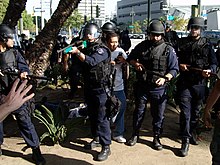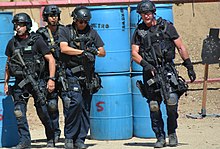
The United Federated Forces of the Symbionese Liberation Army was a small, American militant far-left organization active between 1973 and 1975; it claimed to be a vanguard movement. The FBI and wider American law enforcement considered the SLA to be the first terrorist organization to rise from the American left. Six members died in a May 1974 shootout with police in Los Angeles. The three surviving fugitives recruited new members, but nearly all of them were apprehended in 1975 and prosecuted.
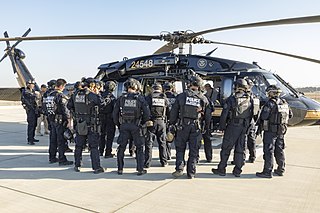
In the United States, a SWAT team is a generic term for a police tactical unit.
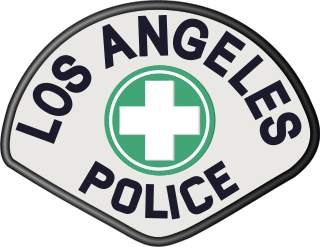
The Los Angeles Police Department (LAPD), officially known as the City of Los Angeles Police Department, is the primary law enforcement agency of Los Angeles, California, United States. With 8,832 officers and 3,000 civilian staff, it is the third-largest municipal police department in the United States, after the New York City Police Department and the Chicago Police Department.

Adam-12 is an American police procedural crime drama television series created by Robert A. Cinader and Jack Webb and produced by Mark VII Limited and Universal Television. The series follows Los Angeles Police Department (LAPD) officers Pete Malloy and Jim Reed as they patrol Los Angeles in their police cruiser, assigned the call sign "1-Adam-12". Adam-12 stars Martin Milner and Kent McCord, with several recurring co-stars, the most frequent being William Boyett and Gary Crosby. The series ran over seven seasons from September 21, 1968, until May 20, 1975.

S.W.A.T. is a 2003 American action crime thriller film directed by Clark Johnson and written by David Ayer and David McKenna, with the story credited to Ron Mita and Jim McClain. Produced by Neal H. Moritz, it is based on the 1975 television series of the same name and stars Samuel L. Jackson, Colin Farrell, Michelle Rodriguez, LL Cool J, Josh Charles, Jeremy Renner, Brian Van Holt and Olivier Martinez. The plot follows Hondo (Jackson) and his SWAT team as they are tasked to escort an imprisoned drug kingpin/international fugitive to prison after he offers a $100 million reward to anyone who can break him out of police custody.

Daryl Francis Gates was an American police officer who served as chief of the Los Angeles Police Department from 1978 to 1992. His length of tenure in this position was second only to that of William H. Parker. Gates is credited with the creation of SWAT teams alongside fellow Los Angeles Police Department (LAPD) officer John Nelson, who others claim was the originator of SWAT in 1965. Gates also co-founded the Drug Abuse Resistance Education program.

SWAT 3: Close Quarters Battle is a 1999 tactical first-person shooter video game developed by Sierra Northwest and published by Sierra Entertainment exclusively for Microsoft Windows. It is the seventh installment of the Police Quest series and the third installment in the SWAT subseries. SWAT 3 follows the Los Angeles Police Department (LAPD) Metropolitan Division SWAT team as they combat a wave of violent crime and terrorism in Los Angeles in the lead-up to a nuclear disarmament treaty signing.
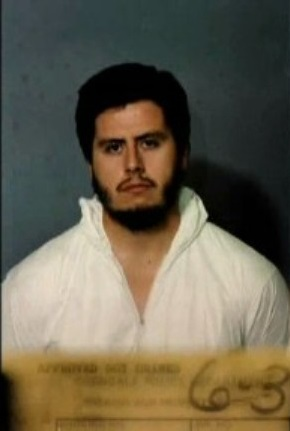
The North Hollywood shootout, also known as the Battle of North Hollywood, was a confrontation between two heavily armed and armored bank robbers, Larry Phillips Jr. and Emil Mătăsăreanu, and police officers in the North Hollywood neighborhood of Los Angeles on February 28, 1997. Both robbers were killed, twelve police officers and eight civilians were injured, and numerous vehicles and other property were damaged or destroyed by the nearly 2,000 rounds of ammunition fired by the robbers and police.

A shootout, also called a firefight, gunfight, or gun battle, is a combat situation between armed parties using guns. The term can be used to describe any such fight, though it is typically used in a non-military context or to describe combat situations primarily using firearms.

The Rampart Division of the Los Angeles Police Department (LAPD) serves communities to the west of Downtown Los Angeles (DTLA) including Silver Lake, Echo Park, Pico-Union and Westlake, all together designated as the Rampart patrol area. Its name is derived from Rampart Boulevard, one of the principal thoroughfares in its patrol area. The original station opened in 1966, located at 2710 West Temple Street. In 2008, the staff moved southeast to a newer facility located at 1401 West 6th Street. With 164,961 residents occupying a 5.4-square-mile (14 km2) area, Rampart is one of Los Angeles's most densely populated communities.

Police Quest: SWAT 2 (stylized as SWAT2) is a 1998 real-time tactics video game developed by Yosemite Entertainment and published by Sierra FX (both studios of Sierra On-Line) exclusively for Microsoft Windows. It is the sixth installment in the Police Quest series and the second installment in the SWAT subseries. The game follows the Los Angeles Police Department (LAPD) Metropolitan Division SWAT team as they clash with a domestic terrorist militia launching attacks across Los Angeles.

LAPD: Life on the Beat is an American reality television series that follows officers of the Los Angeles Police Department, as they respond to various incidents within their precincts' jurisdiction. The program aired in first-run syndication from September 11, 1995, to September 10, 1999. Like its contemporary, COPS, LAPD followed police officers on patrol and during investigations. Unlike COPS, Life on the Beat only featured police officers from the Los Angeles Police Department (LAPD). The series was originally titled as simply LAPD for its first season in 1995, before adopting the expanded title in 1996, in conjunction with the introduction of an upgraded graphical look.

44 Minutes: The North Hollywood Shoot-Out is a 2003 American crime action docudrama television film directed by Yves Simoneau and written by Tim Metcalfe. The film stars Michael Madsen, Ron Livingston, Mario Van Peebles, Andrew Bryniarski, and Oleg Taktarov. It is a semi-fictional dramatization of the 1997 North Hollywood shootout, and follows the perspectives of bank robbers Larry Eugene Phillips Jr. and Emil Mătăsăreanu, as well as various Los Angeles Police Department (LAPD) officers involved in the shootout.

The Los Angeles Police Department (LAPD), the primary law enforcement agency of Los Angeles, California, United States, maintains and uses a variety of resources that allow its officers to effectively perform their duties. The LAPD's organization is complex with the department divided into bureaus and offices that oversee functions and manage specialized units. The LAPD's resources include the department's divisions, transportation, communications, and technology.

The Los Angeles Police Department (LAPD) was formed in 1869, and has since become the third-largest law enforcement agency in the United States. They have been involved in various events in history, such as the Black Dahlia murder, the Watts riots, the 1992 Los Angeles riots, the North Hollywood shootout, the murder trial of O. J. Simpson, and the Rampart scandal.
Crime in Los Angeles has varied throughout time, reaching peaks between the 1970s and 1990s. Since the early 2020s, crime has increased in Los Angeles.
Mervin Paul King was a Captain for the Los Angeles Police Department who commanded officers during the SLA shootout in 1974.
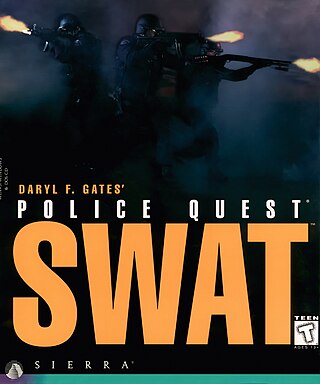
Police Quest: SWAT, alternatively known as Daryl F. Gates' Police Quest: SWAT or Police Quest 5: SWAT, is a 1995 graphic adventure educational video game developed and published by Sierra On-Line for DOS, Microsoft Windows, and Mac OS. It is the fifth installment in the Police Quest series and the first installment in the SWAT subseries. The game follows a Los Angeles Police Department (LAPD) Metropolitan Division SWAT team as they train to handle high-risk criminal incidents across Los Angeles.
The Special Investigation Section (SIS), unofficially nicknamed the "Death Squad", is the tactical detective and surveillance unit of the Los Angeles Police Department (LAPD). It is organized under the Robbery–Homicide Division (RHD), a division of the Detective Bureau, itself under the Office of Special Operations. Formed in 1965, the SIS's unconventional tactics and involvement in numerous shootouts and police shootings have elicited considerable controversy.

